Patient Referral Letter
[Your Name]
[Your Title/Position]
[Your Medical Facility]
[Address]
[City, State, ZIP Code]
[Email Address]
[Phone Number]
[Date: mm/dd/yyyy]
[Referring Physician's Name]
[Referring Physician's Title/Position]
[Referring Physician's Medical Facility]
[Address]
[City, State, ZIP Code]
Dear Dr. [Referring Physician's Last Name],
Re: Referral for Patient Care – [Patient's Full Name]
DOB: [Patient's Date of Birth]
Gender: [Patient's Gender]
Medical Record No: [Patient's Medical Record Number]
Date of Initial Consultation: [Date of Initial Consultation]
I hope this letter finds you well. I am writing to formally refer my patient, [Patient's Full Name], for your expert evaluation and potential ongoing management. I believe that your specialized skills and knowledge will greatly benefit the care and treatment of this individual.
Patient [Patient's Last Name] is [age]-year-old [male/female] who initially presented to my clinic with the following medical concerns: [Brief summary of presenting symptoms or medical conditions]. Following a thorough assessment and [relevant diagnostic tests/procedures], I have determined that further consultation and care from your medical team is warranted.
I am particularly concerned about [specific reason for referral, e.g., a suspected diagnosis, need for specialized treatment, surgical opinion, etc.]. Given your extensive experience in [specialty], I believe that your insights will contribute significantly to the patient's well-being.
Please find attached or enclosed the relevant medical records, test results, and imaging reports for your review. I kindly request that you assess the patient's condition and provide your recommendations for further management. Additionally, I would appreciate your insights on the most suitable treatment plan, potential interventions, and any urgent steps that should be taken.
I understand the importance of clear and timely communication in patient care, and I trust that you will keep me informed of your evaluation findings and proposed management plan. Collaboration between our medical teams will ensure the best possible outcome for the patient.
Thank you for your attention to this matter. I have full confidence in your abilities and look forward to your expert guidance in managing this patient's health. Please do not hesitate to contact me at [your phone number] or [your email address] if you require any additional information or if there are any specific points you would like to discuss.
Warm regards,
[Your Signature]
[Your Printed Name]
[Your Title/Position]
[Your Medical Facility]
[Contact Information]
Enclosures: [List of enclosed documents, e.g., medical records, test results, imaging reports, etc.]
CC: [Other relevant parties to receive a copy of the referral letter, if applicable]
Formal Patient Referral Letter to a Specialist
Subject: Referral for Specialist Consultation
Dear Dr. [Specialist Name],
I am referring my patient, [Patient Name], aged [Age], for a specialist consultation regarding [Medical Condition]. The patient has been under my care since [Date] and has not responded adequately to initial treatments.
Enclosed are the patient's medical history, lab reports, and imaging results. Your expertise in [Specialty] is requested to provide further evaluation and management.
Please let me know your assessment and recommended treatment plan.
Sincerely,
[Referring Physician Name]
[Clinic/Hospital Name]
Provisional Patient Referral Letter for Emergency Cases
Subject: Urgent Referral for Immediate Evaluation
Dear [Specialist Name],
I am urgently referring [Patient Name], aged [Age], who presents with [Symptoms/Condition] that requires immediate specialist attention. Initial interventions have been provided, but further evaluation is necessary.
Please find attached preliminary test results and vital information. Your prompt assessment is highly appreciated.
Sincerely,
[Referring Physician Name]
[Clinic/Hospital Name]
Informal Referral Message for Teleconsultation
Subject: Referral for Online Consultation
Hi [Specialist Name],
I am referring my patient, [Patient Name], for a teleconsultation regarding [Condition]. The patient has been experiencing [Symptoms] and would benefit from your remote assessment.
All necessary reports are attached in this message. Please advise on next steps and any additional information required.
Best regards,
[Referring Physician Name]
Heartfelt Referral Letter for Pediatric Patient
Subject: Referral for Pediatric Specialist Care
Dear Dr. [Specialist Name],
I am referring my young patient, [Patient Name], aged [Age], for specialized pediatric evaluation. The child has been struggling with [Medical Condition], and further specialized care is essential for their well-being.
I have included detailed medical records and test results. Your expertise will be invaluable in guiding treatment and providing reassurance to the family.
Thank you for your attention to this referral.
Sincerely,
[Referring Physician Name]
[Clinic/Hospital Name]
Official Referral Letter for Diagnostic Imaging
Subject: Referral for Diagnostic Imaging
Dear [Imaging Center Name/Technician],
Please find referred patient [Patient Name], aged [Age], requiring [Type of Imaging, e.g., MRI, CT scan] for evaluation of [Condition]. Previous clinical assessment suggests further imaging is necessary.
Attached are the patient's history, preliminary lab results, and prior imaging. Kindly conduct the requested procedure and forward the findings to my office.
Sincerely,
[Referring Physician Name]
[Clinic/Hospital Name]
Quick Referral Email for Routine Check-Up
Subject: Routine Patient Referral
Hi [Specialist Name],
I am referring [Patient Name] for a routine evaluation regarding [Condition]. All current reports and test results are attached.
Thank you for your assistance.
Best,
[Referring Physician Name]
Professional Referral Letter for Mental Health Services
Subject: Referral for Psychological Evaluation
Dear Dr. [Specialist Name],
I am referring [Patient Name], aged [Age], for mental health evaluation and support. The patient has been experiencing [Symptoms/Concerns] that warrant specialized psychological assessment.
Attached are the relevant medical and psychiatric history. Your expertise in providing diagnosis and therapy options will be greatly appreciated.
Sincerely,
[Referring Physician Name]
[Clinic/Hospital Name]
Creative Referral Letter for Multidisciplinary Care
Subject: Referral for Multidisciplinary Management
Dear Team,
I am referring [Patient Name], aged [Age], who requires coordinated care from multiple specialists, including [Specialties]. The patient presents with complex symptoms including [Details] that require collaborative evaluation.
Attached are comprehensive reports, lab results, and preliminary treatment history. Kindly coordinate care and provide your assessments accordingly.
Thank you for your collaboration.
Sincerely,
[Referring Physician Name]
[Clinic/Hospital Name]
What is a Patient Referral Letter and Why It Is Used
- A patient referral letter is a formal document from a healthcare provider requesting that a patient receive specialized medical care from another professional.
- Its purpose is to communicate patient history, current condition, and required assessments clearly to ensure continuity of care.
- Referral letters are crucial for patient safety, appropriate management, and documentation of medical processes.
Who Should Send a Patient Referral Letter
- Primary care physicians, general practitioners, or family doctors referring patients to specialists.
- Hospitalists or attending physicians requesting further evaluation.
- Clinics or telemedicine providers arranging for expert assessment.
Whom Should Receive a Patient Referral Letter
- Specialists such as cardiologists, neurologists, surgeons, or psychiatrists.
- Diagnostic facilities, laboratories, and imaging centers.
- Multidisciplinary care teams or rehabilitation centers.
When Should a Patient Referral Letter Be Issued
- When a patient requires specialized care beyond the primary physician's expertise.
- Prior to diagnostic tests or imaging that need interpretation by a specialist.
- For ongoing chronic conditions requiring multidisciplinary management.
- In urgent or emergency cases necessitating immediate referral.
How to Write and Send a Patient Referral Letter
- Begin with a clear subject line stating the referral purpose.
- Address the specialist or facility personally.
- Provide patient demographics, relevant history, and current diagnosis.
- Include all pertinent test results, reports, and previous treatment plans.
- Specify the reason for referral and any urgent considerations.
- Send via secure email, fax, or printed letter according to confidentiality regulations.
Requirements and Prerequisites for a Referral Letter
- Complete patient medical records and history.
- Updated lab tests, imaging, and relevant reports.
- Clear indication of reason for referral and urgency.
- Ensure patient consent for sharing medical information with another provider.
Formatting Guidelines for Patient Referral Letters
- Length: one to two pages is sufficient.
- Tone: formal and professional.
- Structure: subject, greeting, patient information, medical history, reason for referral, attachments, closing.
- Include clear contact details for follow-up or additional questions.
- Attach all relevant documentation as appendices.
After Sending a Patient Referral Letter
- Confirm receipt with the receiving specialist or facility.
- Follow up to ensure the patient has been scheduled for evaluation.
- Maintain documentation of referral in the patient’s medical record.
- Communicate any urgent updates promptly.
Pros and Cons of Sending a Patient Referral Letter
Pros:
- Ensures continuity and quality of patient care.
- Provides a documented medical communication trail.
- Helps specialists prepare for patient evaluation efficiently.
Cons:
- Potential delays if the letter is incomplete or unclear.
- Risk of miscommunication if patient history is not thorough.
- Additional administrative workload for the referring provider.
Common Mistakes in Patient Referral Letters
- Omitting critical patient information or test results.
- Failing to specify the reason for referral clearly.
- Using vague or informal language.
- Not confirming patient consent for sharing medical data.
- Sending incomplete or disorganized documentation.
Elements and Structure of a Patient Referral Letter
- Subject line: Clearly states referral reason.
- Greeting: Address to the specialist or facility.
- Patient Information: Name, age, gender, relevant identifiers.
- Medical History: Summary of diagnosis, treatments, medications.
- Reason for Referral: Urgency, specific evaluations required.
- Attachments: Lab reports, imaging, test results.
- Closing: Contact info for further correspondence and signature.
Tips and Best Practices for Referral Letters
- Personalize each referral for the receiving specialist.
- Include concise but complete medical history.
- Highlight urgent cases with clear notation.
- Use secure and confidential transmission methods.
- Follow up to ensure the referral has been received and acted upon.
Does a Patient Referral Letter Require Attestation or Authorization?
- Certain referrals, particularly to specialized hospitals or insurance-covered treatments, may require authorization or pre-approval.
- Patient consent for sharing medical records is mandatory.
- For legal or insurance purposes, official signatures of the referring physician are often required.
Compare and Contrast Patient Referral Letters with Other Communication Methods
- Referral Letter vs. Direct Phone Call: Letters provide documentation; calls allow immediate clarification but lack record.
- Referral Letter vs. Email/Message: Emails may be faster and more convenient, but letters ensure formal communication and permanence.
- Referral Letter vs. Internal Note: Letters are used when transferring care to another provider; notes remain within the same facility.

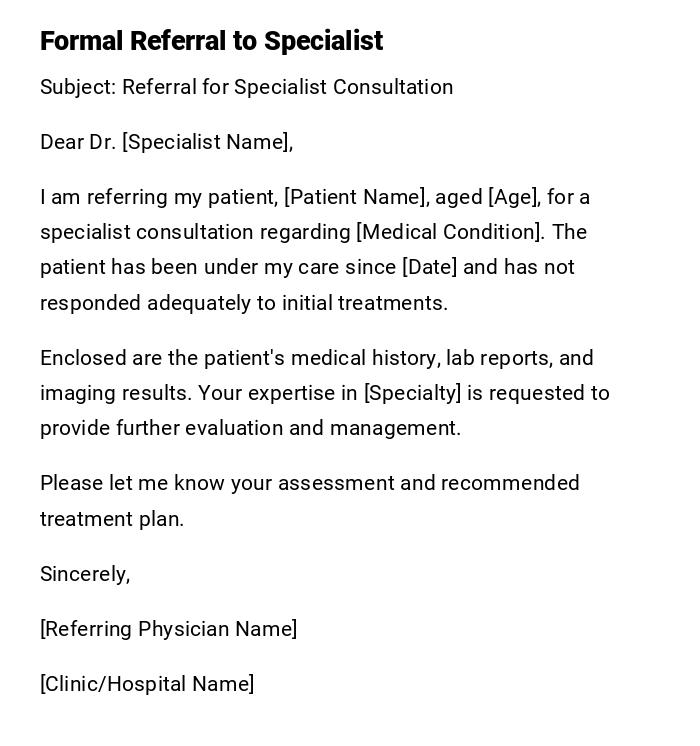
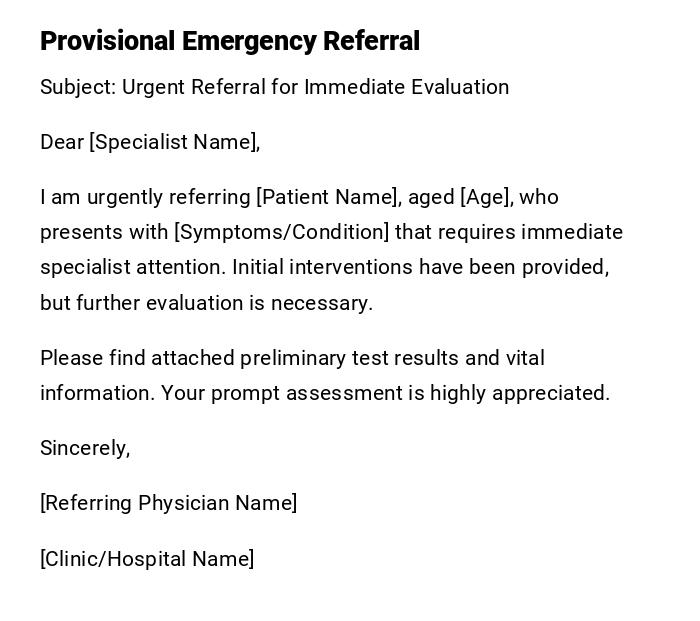
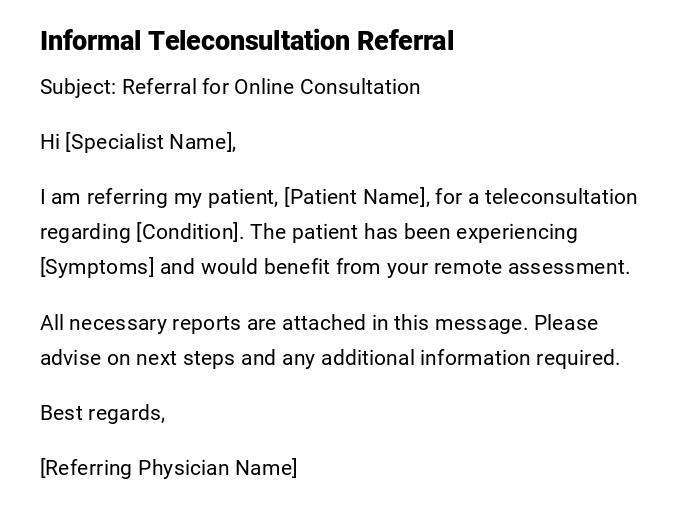
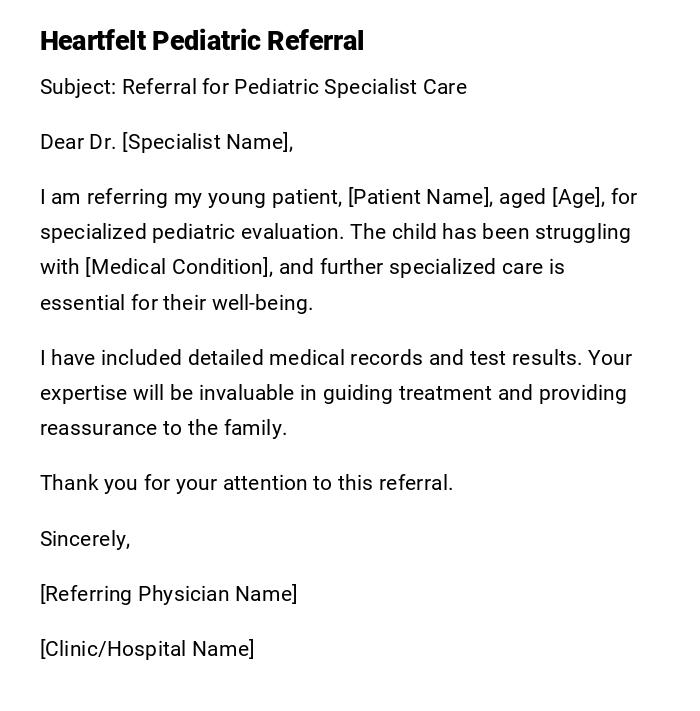
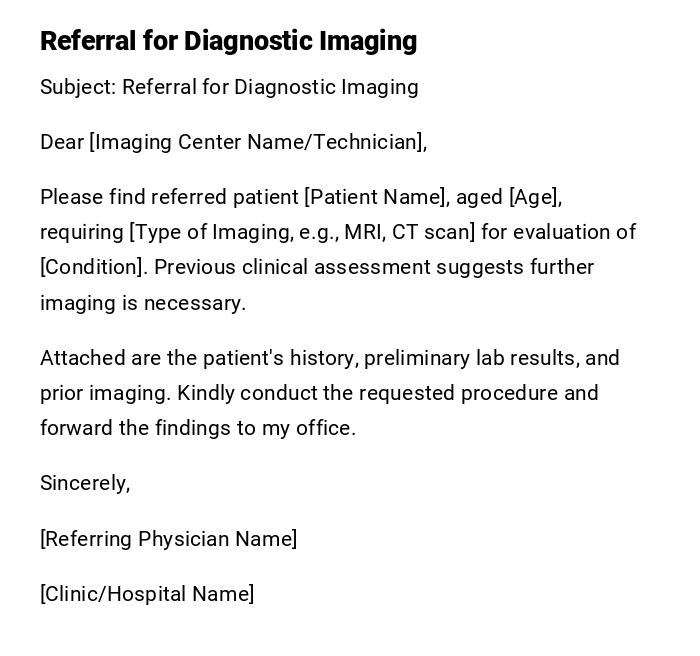
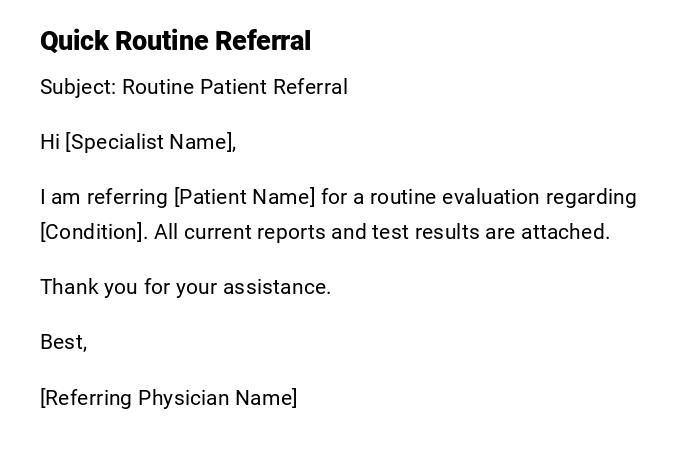
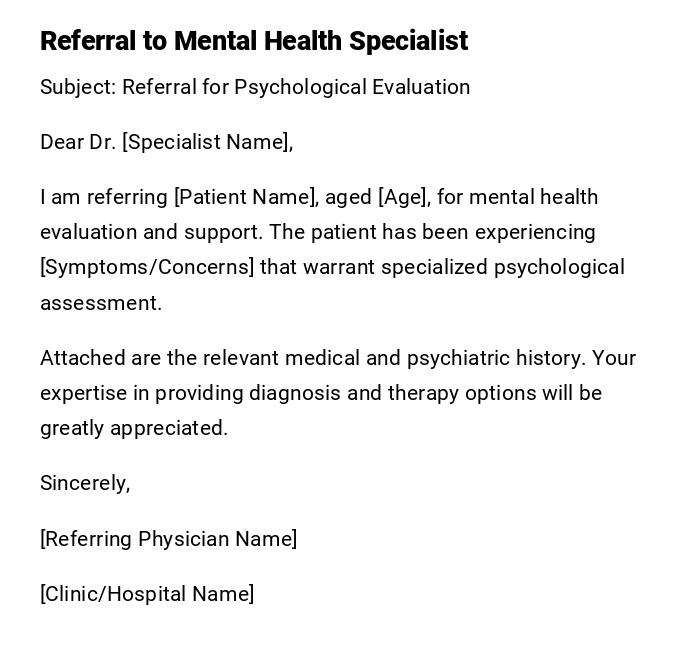
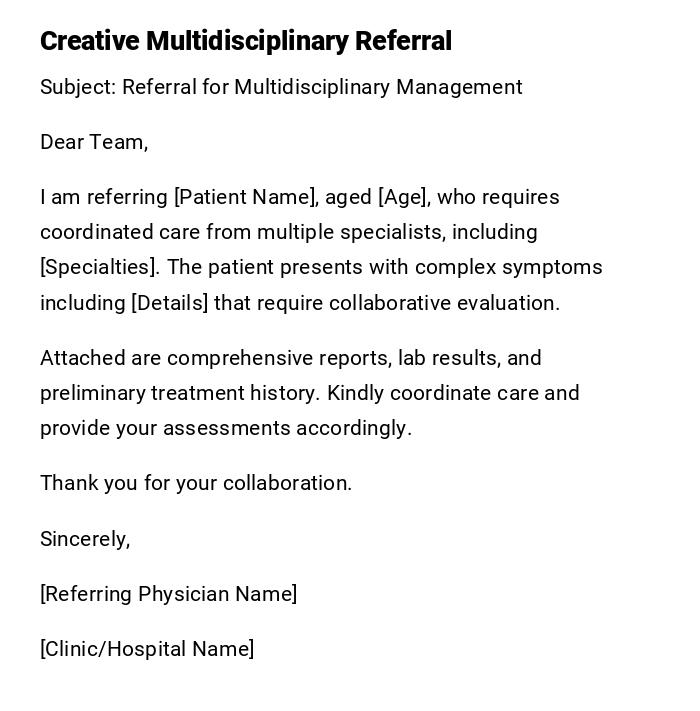

 Download Word Doc
Download Word Doc
 Download PDF
Download PDF